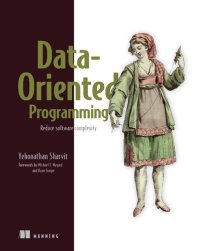
Ebook: Data-Oriented Programming: Reduce complexity by rethinking data
Author: Yehonathan Sharvit
- Genre: Computers // Programming
- Tags: Software Engineering, Databases, Debugging, Data Structures, Concurrency, Object-Oriented Programming, Unit Testing, Data Modeling, Complexity, Programming Paradigms, Polymorphism, Data-Oriented Programming
- Year: 2022
- Publisher: Manning Publications
- City: Shelter Island, NY
- Edition: 1
- Language: English
- pdf
Eliminate the unavoidable complexity of object-oriented designs. The innovative data-oriented programming paradigm makes your systems less complex by making it simpler to access and manipulate data.
In Data-Oriented Programming you will learn how to:
• Separate code from data
• Represent data with generic data structures
• Manipulate data with general-purpose functions
• Manage state without mutating data
• Control concurrency in highly scalable systems
• Write data-oriented unit tests
• Specify the shape of your data
• Benefit from polymorphism without objects
• Debug programs without a debugger
Data-Oriented Programming is a one-of-a-kind guide that introduces the data-oriented paradigm. This groundbreaking approach represents data with generic immutable data structures. It simplifies state management, eases concurrency, and does away with the common problems you’ll find in object-oriented code. The book presents powerful new ideas through conversations, code snippets, and diagrams that help you quickly grok what’s great about DOP. Best of all, the paradigm is language-agnostic—you’ll learn to write DOP code that can be implemented in JavaScript, Ruby, Python, Clojure, and also in traditional OO languages like Java or C#.
About the technology
Code that combines behavior and data, as is common in object-oriented designs, can introduce almost unmanageable complexity for state management. The Data-oriented programming (DOP) paradigm simplifies state management by holding application data in immutable generic data structures and then performing calculations using non-mutating general-purpose functions. Your applications are free of state-related bugs and your code is easier to understand and maintain.
About the book
Data-Oriented Programming teaches you to design software using the groundbreaking data-oriented paradigm. You’ll put DOP into action to design data models for business entities and implement a library management system that manages state without data mutation. The numerous diagrams, intuitive mind maps, and a unique conversational approach all help you get your head around these exciting new ideas. Every chapter has a lightbulb moment that will change the way you think about programming.
What's inside
• Separate code from data
• Represent data with generic data structures
• Manage state without mutating data
• Control concurrency in highly scalable systems
• Write data-oriented unit tests
• Specify the shape of your data
About the reader
For programmers who have experience with a high-level programming language like JavaScript, Java, Python, C#, Clojure, or Ruby.
About the author
Yehonathan Sharvit has over twenty years of experience as a software engineer. He blogs, speaks at conferences, and leads Data-oriented programming workshops around the world.
In Data-Oriented Programming you will learn how to:
• Separate code from data
• Represent data with generic data structures
• Manipulate data with general-purpose functions
• Manage state without mutating data
• Control concurrency in highly scalable systems
• Write data-oriented unit tests
• Specify the shape of your data
• Benefit from polymorphism without objects
• Debug programs without a debugger
Data-Oriented Programming is a one-of-a-kind guide that introduces the data-oriented paradigm. This groundbreaking approach represents data with generic immutable data structures. It simplifies state management, eases concurrency, and does away with the common problems you’ll find in object-oriented code. The book presents powerful new ideas through conversations, code snippets, and diagrams that help you quickly grok what’s great about DOP. Best of all, the paradigm is language-agnostic—you’ll learn to write DOP code that can be implemented in JavaScript, Ruby, Python, Clojure, and also in traditional OO languages like Java or C#.
About the technology
Code that combines behavior and data, as is common in object-oriented designs, can introduce almost unmanageable complexity for state management. The Data-oriented programming (DOP) paradigm simplifies state management by holding application data in immutable generic data structures and then performing calculations using non-mutating general-purpose functions. Your applications are free of state-related bugs and your code is easier to understand and maintain.
About the book
Data-Oriented Programming teaches you to design software using the groundbreaking data-oriented paradigm. You’ll put DOP into action to design data models for business entities and implement a library management system that manages state without data mutation. The numerous diagrams, intuitive mind maps, and a unique conversational approach all help you get your head around these exciting new ideas. Every chapter has a lightbulb moment that will change the way you think about programming.
What's inside
• Separate code from data
• Represent data with generic data structures
• Manage state without mutating data
• Control concurrency in highly scalable systems
• Write data-oriented unit tests
• Specify the shape of your data
About the reader
For programmers who have experience with a high-level programming language like JavaScript, Java, Python, C#, Clojure, or Ruby.
About the author
Yehonathan Sharvit has over twenty years of experience as a software engineer. He blogs, speaks at conferences, and leads Data-oriented programming workshops around the world.
Download the book Data-Oriented Programming: Reduce complexity by rethinking data for free or read online
Continue reading on any device:

Last viewed books
Related books
{related-news}
Comments (0)